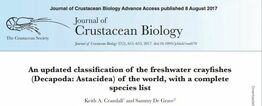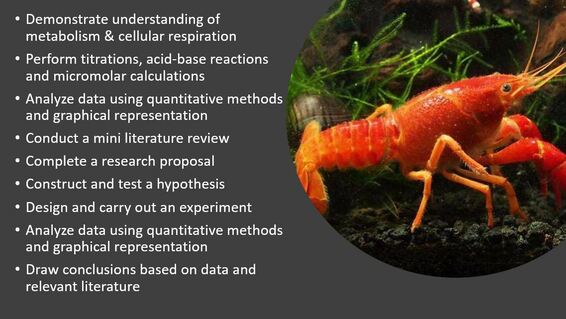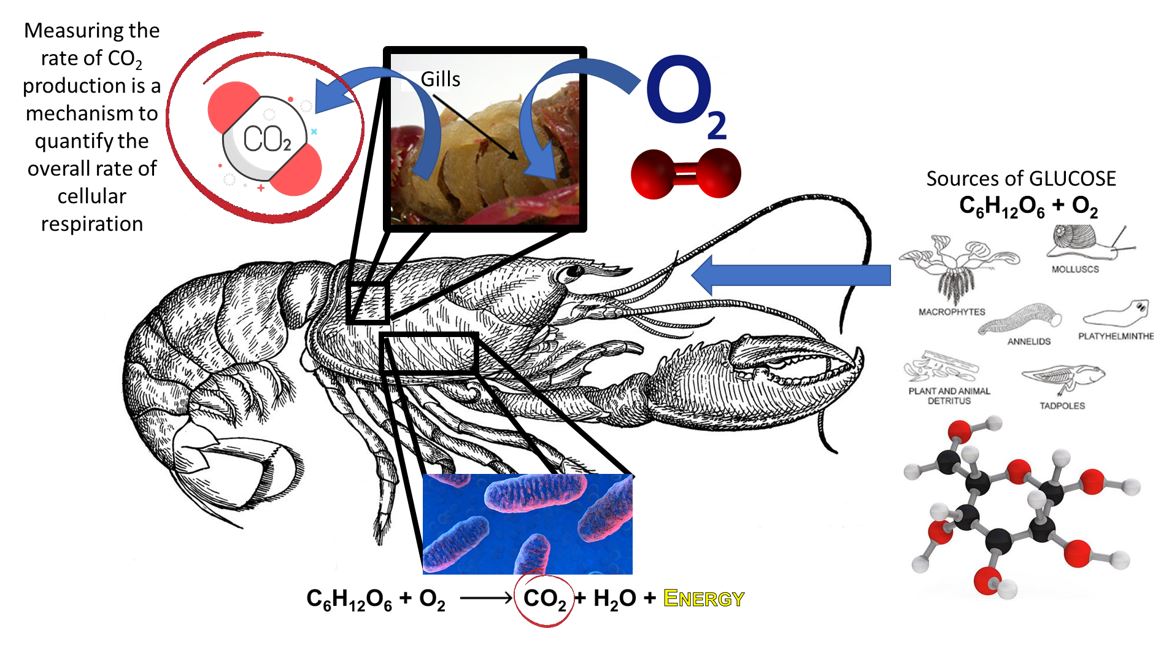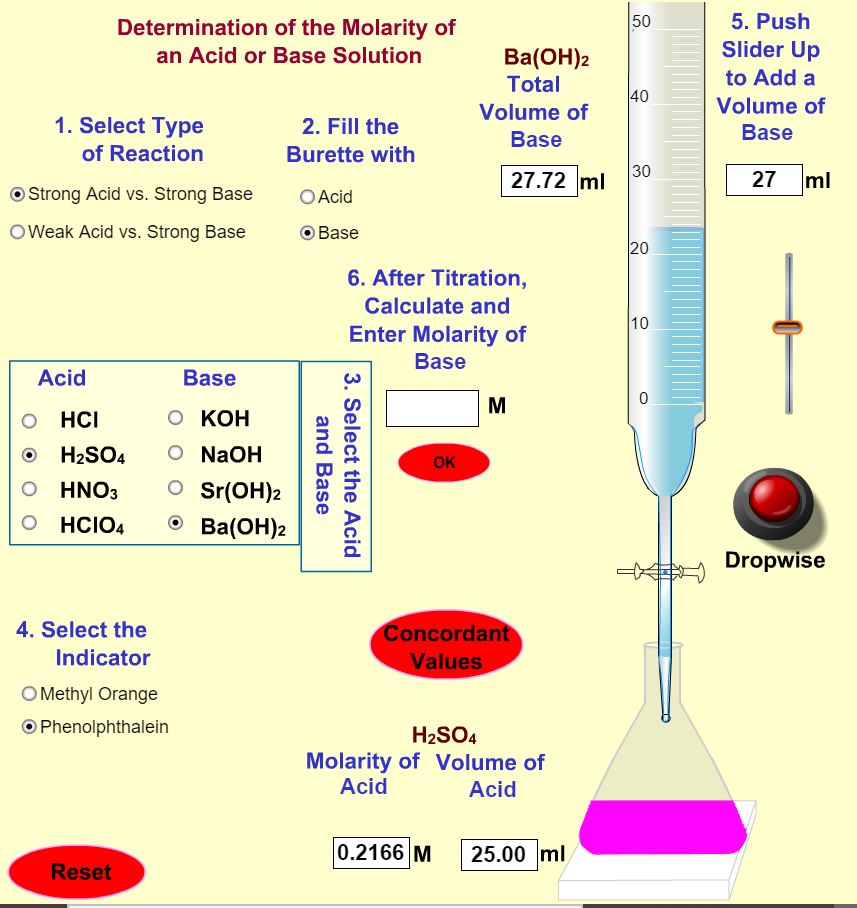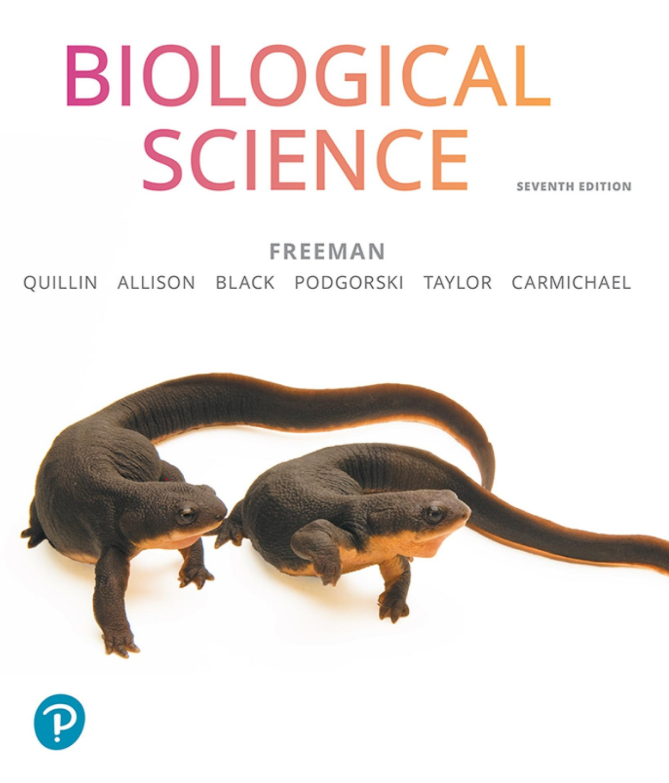Lab 7: Pre-Lab
Your task in Lab 7 is to carryout your experiment regarding the rate of cellular respiration and begin to analyze your data. To prepare for Lab 7, please review this pre-lab page. Once you feel confident regarding the below topics, complete the corresponding pre-lab quiz in Blackboard.
-
Introduction/Review
-
Do you know enough?
-
What will we do in lab?
-
LABridge
<
>
Cellular Respiration
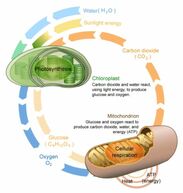 Click to Enlarge
Click to Enlarge
Energy is the currency of life: all living organisms require energy to survive and reproduce. Metabolism is the series of reactions and processes, catalyzed by enzymes, which together maintain life. These reactions fall into two types: catabolic or anabolic. These processes are the inverse of each other and in photosynthetic organisms occur in tandem as the anabolic reactions of photosynthesis create the products that are then broken down by the catabolic reactions of cellular respiration.
There are two general classes of cellular respiration that are characterized by their relative efficiency (ATP production): anaerobic (without oxygen) and aerobic (oxygenated) respiration. We are focusing on aerobic respiration in this lab, which is a highly efficient process occurring within the mitochondria of eukaryotic organisms that have higher energy requirements for survival. In a 4 step process, oxygen and glucose are used to produce energy (ATP), H2O, and CO2,.
There are two general classes of cellular respiration that are characterized by their relative efficiency (ATP production): anaerobic (without oxygen) and aerobic (oxygenated) respiration. We are focusing on aerobic respiration in this lab, which is a highly efficient process occurring within the mitochondria of eukaryotic organisms that have higher energy requirements for survival. In a 4 step process, oxygen and glucose are used to produce energy (ATP), H2O, and CO2,.
CONNECTION! Cellular respiration is the topic of Chapter 9 in your BIOL 120 lecture. Please review your textbook as needed for this lab. The most important thing you need to know for Lab 6, are the reactants and products of aerobic cellular respiration.
Do you know enough about crayfish?
The freshwater crayfishes (Order Decapoda) are one of the better known crustacean groups in Kentucky. Worldwide, freshwater crayfishes are represented by over 640 species (Crandall and Buhay 2008) with the southeastern United States being one of the epicenters of diversity. Three hundred sixty species are represented in the United States (Taylor et al. 2007). All of Kentucky is home to one of the richer freshwater crayfish faunas in North America with 54 species, with some of those species still under taxonomic review and others potentially awaiting discovery. Seven species are endemic to the state of Kentucky. Modification of habitats, sedimentation, and dams are serious threats to freshwater crayfishes. A larger threat that has not yet impacted Kentucky is the introduction and establishment of nonnative crayfishes.
|
Several studies have shown the displacement of native species by more aggressive or opportunistic non-native species (Capelli 1982; Taylor and Redmer 1996; Hill and Lodge 1999). Many introductions are suspected to be from fisherman dumping their purchased live crayfish into the stream at the end of the day. Nationally, about 48% of crayfish species are of conservation concern (ranging from Vulnerable to Endangered); over a third (37%) of the Kentucky fauna falls into this category (KSNPC, 2010). Cave species are particularly at-risk from upland activities that pollute groundwater flowing into cave systems; this includes issues with chemical spills, agricultural runoff, salt from roads, and siltation from poor land use. Best Management Practices are needed to guard against perturbations to groundwater.
-Excperpted from the Kentucky Wildlife Action Plan (WAP) |
What will we do in lab & how will we do it?
|
Your task is to design and conduct an experiment that tests the affects of one variable on the rate of cellular respiration in crayfish (AKA craw-fish or crawl-dad). Crayfish are freshwater crustaceans that breathe through feather-like gills. There are over 50 species of crayfish known from Kentucky's streams, lakes, caves, wetlands, and other freshwater habitats. Like most animals, they rely on aerobic cellular respiration to meet their energy demands. Use the resources at the right to familiarize yourself with this gregarious invertebrate!
|
REMEMBER! REMEMBER! You are designing this experiment so you get to chose the variable you are interested in. Your options include: environmental temperature, oxygen concentration, glucose concentration, nitrogen (NH4) concentration, and crayfish sex and size. You will begin the lab by conducting some research on crayfish respiration and your variable of choice!
How will we measure the rate of cellular respiration? ...By measuring the CO2 produced as a bi-product of the metabolic process! You will place your crayfish in an aquatic environment and allow it to "respire." After a set period of time (decided by you), you will remove the crayfish and analyze how much CO2 was produced as a result of cellular respiration. Review the following steps to understand how we will quantify respiration rate.
- The water you will place your crayfish in will be slightly basic and will appear pink! This is because it will contain a pH indicator called, phenolphthalein, which is pink in the presence of a base and turns clear when it approaches neutral (pH=7).
- As cellular respiration is occurring inside your crayfish, CO2 will be expelled into the solution as a bi-product. In an aqueous environment, this CO2 breaks down into carbonic acid (H2CO3) then into bicarbonate (HCO3-) and H+ ions.
- Increased concentrations of H+ ions increase the acidity in solution and lower the pH. As the pH decreases the solution will turn from pink (basic) to clear (neutral). BUT! We cannot wait for that to happen on its own, it would take far too long!
- So...after your crayfish "respires" in solution for your set period time, you will remove it. The water will still appear pink. Some respiration and CO2 production HAS occurred, but not enough to change the pH enough to see a color change. So we will add more acid to the solution (H2SO4), via titration, until we see a color change from pick to clear. View Diagram.
- Lastly, you will use the "amount of titrant used" to calculate the micromoles of carbonic acid (H2CO3) produced in solution using this equation.
The slideshow below goes over each step!
-
Headline 0
-
Headline 1
<
>
Exercise I. Prepare
Review the pre-lab as a group. Ask yourselves the following questions. Be prepared to discuss them before you begin your experiment today as well as other content related questions. After discussing the questions below, augment/revise your proposal as necessary.
- What remains unclear?
- How long does your crayfish need to respire?
- How many trials will you do?
- Do you need a control? (YES) ...depending on your experiment. What should it be?
- You will not run the control test. Your instructor will provide you with the titrant required for your specific control.
- What kind of statistics will you use?
- What kind of graph might you make?
Prepare your step-by-step protocol. Can be typed or written. Plan to use your time wisely. Remember, Every crayfish must respire for 20 minutes in your beakers. Plan your timing and protocol accordingly.
Also, remember to determine the volume of your crayfish: Pour 100-200 mL of stock solution into a 250 mL graduated cylinder. Gently place your animal into the graduated cylinder. Record its volume (rise in solution level in mL). Plan to do this for every crayfish you will test today.
Review your provided materials. You are provided with: Gloves & goggles, glass stirring rods, several beakers of various sizes, graduated cylinders of various sizes and 1 burette containing 0.02 N sulfuric acid (H2SO4). If you need more sulfuric acid at anytime today, your instructor will refill your burette.
Collect materials specific to your hypothesis. Collect your crayfish, based on your experiment (do you need special sizes, male vs. female, etc.). Collect your stock solution. All stock solution will appear pink due to phenolphthalein ph indicator and the slightly basic ph. You made need stock solutions of different types depending on the variables you will be testing. For example you may need standard stock solution and stock solution with caffeine added. The special condition stock solutions available to you have been prepared by your instructor. If you're unsure, please review your proposal.
STOP. You must get your instructor's "OK" before you can move-on. She/he will need to go over your protocol before allowing you to proceed.
Exercise III. Analysis
We look for patterns to help us understand the natural world. As we do so, we are fighting our own human tendency to see patterns where none truly exist, and to take what we see in a specific context and try to apply it more broadly.
|
Lab 7: Post-Lab
In Lab 7, you worked with your lab group to develop a research proposal and conduct your own experiment to determine what factors effect the rate of cellular respiration in crayfish. Please complete the 2-part follow-up assignment below regarding the outcomes of Lab 7.
Part I. Add to our Research LibraryHelp us build a better research library. Please find at least one reference that would be relevant to add to our on-line library.
|
Part I. Post Lab Analysis |
Faculty Spotlight: Dr. Noah Ashley
We are conducting experiments to identify factors that affect the physiological process of cellular respiration in crayfish. Similarly, Dr. Noah Ashley's lab works to identify physiological, immunological, and behavioral responses to various factors, like sickness and sleep loss, in mice and birds. Specifically, they are investigating the costs and benefits of the sickness response in vertebrates, the inflammatory response in sleep-deprived mice, sleep loss in migratory birds, and the sleep-wake cycle in arctic songbirds. Dr. Ashley's lab is extremely productive! His research proposals have been funded by the NSF and the NIH. Learn more here (Lab Web Page). You just might recognize one of his current graduate students! |
|
Procedure
|
KAS citation format:
Mountjoy, N.J 2021. Title of page. Biological Concepts: Cells, Metabolism & Genetics. https://www.121cellmetagen.com. Date accessed (MM/DD/YYY).
Mountjoy, N.J 2021. Title of page. Biological Concepts: Cells, Metabolism & Genetics. https://www.121cellmetagen.com. Date accessed (MM/DD/YYY).


